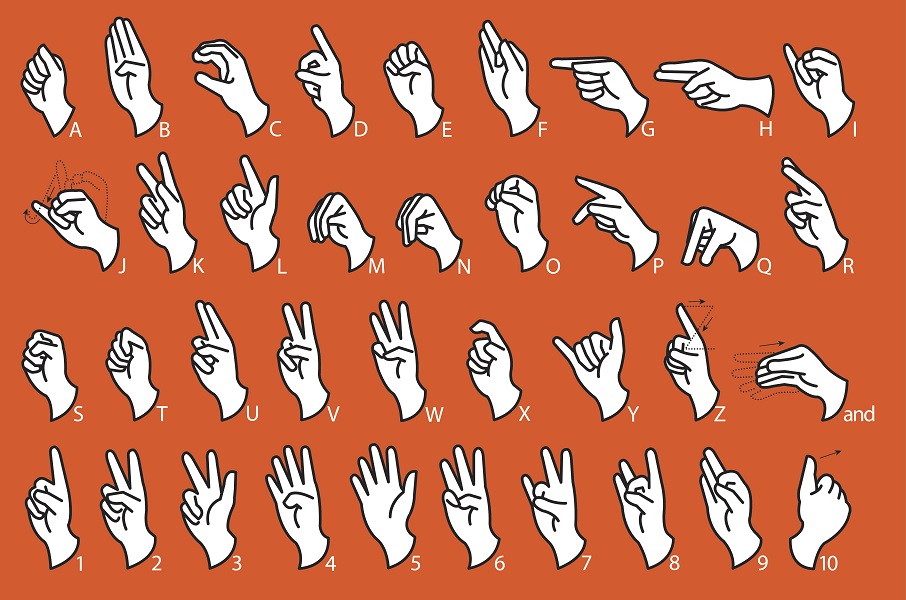Sign Languages Around the World
Even if you don’t speak sign language, you’ve surely encountered it, either by seeing it used in public or through the use of a sign language interpreter at a conference or a concert. There’s a lot more to sign language than meets the eye, however, and many languages other than American Sign Language (ASL). According to HandSpeak.com, there are over 60 sign languages recognized and used around the world.
The National Institute on Deafness and Other Communication Disorders (NIDCD) defines ASL “is a complete, complex language that employs signs made by moving the hands combined with facial expressions and postures of the body.” It is more than simply English turned into gestures; it follows its own grammar and pronunciation rules, and even supports different dialects and accents.
ASL developed in America, but other versions of sign language exist in other areas of the world, accounting for variations in culture and language. In the United Kingdom, signers use British Sign Language (BSL), and it’s generally accepted that Australian Sign Language (Auslan) and New Zealand Sign Language are derived from BSL; the group of languages is referred to as BANZSL. However, differences exist even between the three languages: in New Zealand, Māori words are incorporated into the language, and in Australia, Auslan incorporates certain aspects of Irish Sign Language and a number of indigenous languages as well.
Along with BSL in the UK, some signers may use SSE, or Sign Supported English, which borrows from BSL but follows the same rules as, and is generally used in support of, spoken English. This video has a good overview of the difference between BSL and SSE:
French Sign Language (LSF) is another major sign language used, primarily in France and Switzerland. LSF was one of the first sign languages to be formalized and recognized as an actual language, and ASL is actually based on the mixing of LSF and local signing. LSF was developed out of the sign language already in use by the Parisian deaf community, and taught by Charles Michel de l’Épée at his free school for the deaf. It, too, has dialects, such as Marseille Sign Language, also known as Southern French Language.
You may think that because many countries around the world also speak French, they would also use LSF, but some francophone, or French-speaking, countries have developed their own languages, in large part influenced by their own multilingual nature. In Canada, ASL is used for anglophone regions, and la Langue des Signes Québécois (LSQ) is used in francophone communities. They also have a separate Maritime Sign Language (MSL). Belgians use either the Flemish Belgian Sign Language, or the French Belgian Sign Language.
In Asia, Korean Sign Language was only recently recognized as one of South Korea’s official languages in 2015. Chinese deaf communities have used signing languages for centuries, but the first deaf schools in China were established fairly recently by foreign missionaries. Chinese Sign Language (CSL) has two official dialects: Southern (Shanghai) CSL and Northern (Beijing) CSL. CSL is especially gaining ground and attention throughout online communities, which have become ways to spread awareness about deaf culture, sign language, and the different dialects in use.
For more information on the many sign languages used around the world, check out the resources listed below.
The breadth of sign languages around the world shows that regional and local culture and language are important drivers in the development of sign language—true of any spoken language as well. Many have asked why there isn’t a universal sign language, but to those who sign, that might be like asking why we don’t use a single universal spoken language around the world. Language both informs and is informed by the cultures that use it; even traveling between Spanish-speaking countries will lead to encounters in variations of spoken Spanish. The same is true of sign languages. Certain sign languages like ASL, BSL, and LSF are widely spoken around the world, but the development of other sign languages, and of dialects within those languages, shows the significance in all deaf communities of having languages that better represent their cultures and communication styles.
If you're traveling to a country that uses a sign language other than ASL, try your hand at learning some basic phrases in both the spoken and signed language. You never know when you might need it!
Resources
- NIDCD: American Sign Language
- HandSpeak: Sign Languages Around the World
- A Guide to the Different Types of Sign Language Around the World
- Oxford Dictionaries: Mind your sign language
- National Deaf Children’s Society: Sign Language (UK)
- Ethnologue: French Sign Language
- Ethnologue: Languages of Belgium
- Language - Canadian Association of the Deaf
- Two Sign Languages Given Official Language Status
- HandSpeak: Chinese Sign Language and Chinese Deaf Community
- Making Themselves Heard: Chinese Sign Language & Deaf China Online
